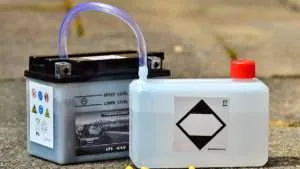Contents
Have your motorcycle’s headlight bulbs ever blown up on you, leaving you in total darkness? Besides leaving you frustrated in the dark, there are also risks of getting into an accident by either getting hit by other motorists or swerving off-road and ending up in a ditch. If this happens to you regularly, you might be left wondering what might be causing the problem.
Blowing light bulbs could be caused by several reasons such as:
- A faulty voltage regulator
- Loose wiring connections to the bulb
- Low-quality bulbs
- Too much condensation in the headlight
However, the problem could also come down to poor maintenance and lack of servicing your motorcycle.
This article will look at what causes a voltage regulator to fail and the common signs of a failing regulator. It will also touch on how to test a faulty voltage regulator and how to prevent headlight bulbs from blowing.
This is Why Your Motorcycle Keeps Blowing Headlight Bulbs

Blown headlight bulbs are a big nightmare for motorcycle owners, especially if you’re on the road. If this problem persists and you don’t know the root cause, it gets agitating. It’s a problem that can consume your time, expose you to unlimited dangers on the road, and, not to mention, leave a burning hole in your pocket.
If your motorcycle has been operating smoothly and starts to blow headlight bulbs one after the other, the problem could be caused by the following conditions:
A Faulty Voltage Regulator
The work of a voltage regulator is to minimize the amount of voltage running through the electric system to keep it optimal for all components’ use. A faulty regulator would not work properly and would allow high voltages to pass through more often, which might be too much for a headlight bulb to handle.
Loose Wiring Connections to the Bulb
Any wiring should be intact and firmly fixed to allow proper electric current movements—loose wiring results in inconsistent electric current movement that might overload the bulb head. A major sign of loose wiring connections is fluctuation in bulb brightness.
Low-Quality Bulbs

Sometimes the problem is caused by buying poor-quality bulbs that don’t perform as needed. Some of these bulbs are cheaper and are mostly counterfeits of the original brands. Make sure to check for the quality mark when purchasing a headlight bulb.
Too Much Condensation In the Headlights
If you’ve seen mist forming inside the headlights lately, you might be facing the condensation problem. Although headlights come equipped with two holes for ventilation, it’s easy for these holes to get clogged, trapping mist inside the headlight. The dampness is caused by heated air from the bulb’s heat and might end up compromising the bulb’s lifespan. Try cleaning the headlights and unblocking the ventilation holes.
Poor Maintenance and Servicing
How often do you take your bike for maintenance? Frequent maintenance and servicing your bike might improve the bulb’s lifespan and eliminate the problem entirely.
What Causes a Voltage Regulator to Fail?

A voltage regulator is handy in keeping the voltage within optimal limits, allowing every electric component to function as needed. It’s so crucial that you risk damaging electric components like the ignition and bulb heads when it starts to fail. Although a damaged voltage regulator is no one’s fault, it’s essential to know what causes this problem so that you can solve it.
- Loose battery connection – Such a connection causes inconsistent power surges that might overload the voltage regulator.
- Damaged ground wire – A ground wire helps to neutralize electric currents passing through the wires. A short circuit will occur on the voltage regulator if it gets damaged.
- Worn-out battery terminals – Battery terminals require regular cleaning to prevent corrosion or wear and tear. Corroded battery terminals don’t transmit the needed voltage, which might damage the voltage regulator.
Common Signs of a Failing Voltage Regulator
- ★ Replaces Harley Davidson voltage regulator Part Numbers: 74505-09, 74505-09a Meets or exceeds OE...
- ★ NEW Premium Quality Harley Davidson Replacement Voltage Regulator,Designed to Run Cooler and Last...
- ★ Computer tested for consistent Quality and Rugged Reliability,2011 harley davidson road king...
Before a voltage regulator fails completely, it gives off some signs, and if you’re careful enough, you might spot them earlier and take proper measures. Make sure you look out for these signs:
- Lights dim or flicker – The inconsistency in brightness is the first sign to check. If the bulbs have been acting up lately, the problem could be the voltage regulator failing.
- Flickering or weak ignition – If it takes several tries to get the ignition working, it’s a sign that the voltage regulator is about to fail.
- Voltage inconsistency – Sometimes you might experience low, high, or no voltage output when starting the bike. However, this problem could also be caused by a failing battery, so be sure to check for this.
How to Test a Faulty Voltage Regulator in a Motorcycle
Although you can test the voltage regulator, it’s recommended you let a trained mechanic handle the test. Even so, here are the crucial steps to follow when testing the voltage regulator:
- Turn off the engine.
- Measure the battery’s voltage using a voltmeter to ensure the voltage is a bit over 12V.
- Start the engine using the ignition key.
- Measure the battery’s voltage again when it’s idling to ensure it’s around 14V.
- Finally, check the voltage after increasing the engine’s RPM to ensure it’s around 14.2V.
If you experience higher voltage readings than this, it’s a sign that the voltage regulator is failing and may need replacing soon.
How to Prevent Headlight Bulbs from Blowing

First, you need to replace a failing voltage regulator to save your motorcycle’s bulbs and other electrical components. Make sure you check the wiring and only buy original bulbs. Regular maintenance and servicing would go a long way to improving the lifespan of motorcycle bulbs.
Final Thoughts
Headlight bulbs keep blowing because of a faulty voltage regulator or wrong wiring. A loose battery connection, worn-out battery terminals, and a damaged ground wire could damage the voltage regulator. Flickering lights and engines are the main signs of a failing voltage regulator. You can test a voltage regulator by using a voltmeter to check for voltage inconsistency.



 Is Your Motorcycle Battery Dead? 8 Symptoms to Look For
Is Your Motorcycle Battery Dead? 8 Symptoms to Look For  Revamped Rumbler: 2022 Harley Davidson Sportster 1250S
Revamped Rumbler: 2022 Harley Davidson Sportster 1250S  The 7 Best WATERPROOF Motorcycle USB Chargers
The 7 Best WATERPROOF Motorcycle USB Chargers  Do Heated Motorcycle Gloves Work?
Do Heated Motorcycle Gloves Work? 